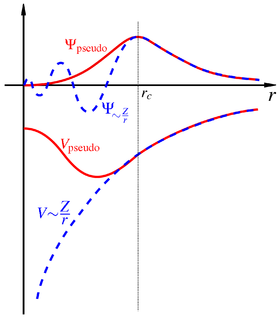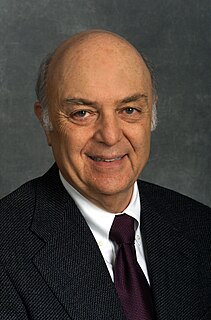
Allotropy or allotropism is the property of some chemical elements to exist in two or more different forms, in the same physical state, known as allotropes of the elements. Allotropes are different structural modifications of an element: the atoms of the element are bonded together in a different manner. For example, the allotropes of carbon include diamond, graphite, graphene, and fullerenes.

PLATO is a suite of programs for electronic structure calculations. It receives its name from the choice of basis set used to expand the electronic wavefunctions.
Quantum 1/f noise is an intrinsic and fundamental part of quantum mechanics. Fighter pilots, photographers, and scientists all appreciate the higher quality of images and signals resulting from the consideration of quantum 1/f noise. Engineers have battled unwanted 1/f noise since 1925, giving it poetic names due to its mysterious nature. The Quantum 1/f noise theory was developed about 50 years later, describing the nature of 1/f noise, allowing it the be explained and calculated via straightforward engineering formulas. It allows for the low-noise optimization of materials, devices and systems of most high-technology applications of modern industry and science. The theory includes the conventional and coherent quantum 1/f effects (Q1/fE). Both effects are combined in a general engineering formula, and present in Q1/f noise, which is itself most of fundamental 1/f noise. The latter is defined as the result of the simultaneous presence of nonlinearity and a certain type of homogeneity in a system, and can be quantum or classical.

In physics, a pseudopotential or effective potential is used as an approximation for the simplified description of complex systems. Applications include atomic physics and neutron scattering. The pseudopotential approximation was first introduced by Hans Hellmann in 1934.
octopus is a software package for performing Kohn–Sham density functional theory (DFT) and time-dependent density functional theory (TDDFT) calculations.
Extremal optimization (EO) is an optimization heuristic inspired by the Bak–Sneppen model of self-organized criticality from the field of statistical physics. This heuristic was designed initially to address combinatorial optimization problems such as the travelling salesman problem and spin glasses, although the technique has been demonstrated to function in optimization domains.

Marvin Lou Cohen is an American theoretical physicist. He is a University Professor of Physics at the University of California, Berkeley. Cohen is a leading expert in the field of Condensed Matter Physics. He is highly cited and most widely known for his seminal work on the electronic structure of solids.
The term R-matrix has several meanings, depending on the field of study.
PARSEC is a package designed to perform electronic structure calculations of solids and molecules using density functional theory (DFT). The acronym stands for Pseudopotential Algorithm for Real-Space Electronic Calculations. It solves the Kohn–Sham equations in real space, without the use of explicit basis sets.
In crystallography, a disclination is a line defect in which rotational symmetry is violated. In analogy with dislocations in crystals, the term, disinclination, for liquid crystals first used by Frederick Charles Frank and since then has been modified to its current usage, disclination. It is a defect in the orientation of director whereas a dislocation is a defect in positional order.
In bulk semiconductor band structure calculations, it is assumed that the crystal lattice of the material is infinite. When the finite size of a crystal is taken into account, the wavefunctions of electrons are altered and states that are forbidden within the bulk semiconductor gap are allowed at the surface. Similarly, when a metal is deposited onto a semiconductor, the wavefunction of an electron in the semiconductor must match that of an electron in the metal at the interface. Since the Fermi levels of the two materials must match at the interface, there exists gap states that decay deeper into the semiconductor.
The hexatic phase is a state of matter that is between the solid and the isotropic liquid phases in two dimensional systems of particles. It is characterized by two order parameters: a short-range positional and a quasi-long-range orientational (sixfold) order. More generally, a hexatic is any phase that contains sixfold orientational order, in analogy with the nematic phase.
The Pandya theorem is a good illustration of the richness of information forthcoming from a judicious use of subtle symmetry principles connecting vastly different sectors of nuclear systems. It is a tool for calculations regarding both particles and holes.
Yambo is a computer software package for studying many-body theory aspects of solids and molecule systems. It calculates the excited state properties of physical systems from first principles, e.g., from quantum mechanics law without the use of empirical data. It is an open-source software released under the GNU General Public License (GPL). However the main development repository is private and only a subset of the features available in the private repository are cloned into the public repository and thus distributed.
The SP formula for the dephasing rate of a particle that moves in a fluctuating environment unifies various results that have been obtained, notably in condensed matter physics, with regard to the motion of electrons in a metal. The general case requires to take into account not only the temporal correlations but also the spatial correlations of the environmental fluctuations. These can be characterized by the spectral form factor , while the motion of the particle is characterized by its power spectrum . Consequently, at finite temperature the expression for the dephasing rate takes the following form that involves S and P functions:
Judy Franz is an American physicist, educator and the former Executive Officer of the American Physical Society.
Suresh Chand Jain was an Indian physicist and director of the Defence Research and Development Organization. Known for his research in solid state physics, Jain was an elected fellow of the Indian National Science Academy and National Academy of Sciences, India. In 1966, the Council of Scientific and Industrial Research, the apex agency of the Government of India for scientific research, awarded him the Shanti Swarup Bhatnagar Prize for Science and Technology, one of the highest Indian science awards for his contributions to physical sciences.
Brian Kidd Ridley is a British solid-state physicist specialising in semiconductor theory. He is an emeritus professor at the University of Essex.
Elizabeth Gardner was a British theoretical physicist. She is best known for her groundbreaking work on a phase transition known as the Gardner transition and on disordered networks.
The FLEUR code is an open-source scientific software package for the simulation of material properties of crystalline solids, thin films, and surfaces. It implements Kohn-Sham density functional theory (DFT) in terms of the all-electron full-potential linearized augmented-plane-wave method. With this, it is a realization of one of the most precise DFT methodologies. The code has the common features of a modern DFT simulation package. In the past, major applications have been in the field of magnetism, spintronics, quantum materials, e.g. in ultrathin films, complex magnetism like in spin spirals or magnetic Skyrmion lattices, and in spin-orbit related physics, e.g. in graphene and topological insulators.




